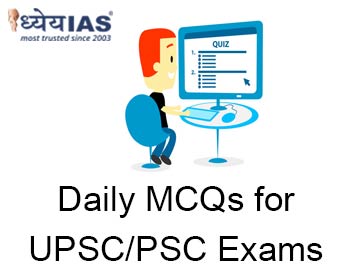Home > Daily-mcqs
Daily-mcqs 15 Apr 2025

Q1:
Consider the following statements regarding India-Italy relations: Which of the statements given above is/are correct?
A: 1 and 2 only
B: 2 only
C: 1 and 3 only
D: 1, 2 and 3
Answer: B
Explanation:
India and Italy have committed to advancing the IMEEC, making statement 2 correct. Italy is among top foreign investors in India, but not top 10, hence 1 is incorrect. The Strategic Partnership was elevated only in 2023, so statement 3 is also incorrect.
Q2:
Which of the following best describes the significance of the Genome India Project (GIP)?
A: It will focus exclusively on mapping genetic data from South Indian populations for future medical applications.
B: It will create a biobank with genetic data that can be used to develop treatments tailored to India’s genetic diversity.
C: The project aims to sequence genomes of individuals from non-Indian ethnic groups to compare global genetic traits.
D: The project seeks to only document common genetic traits of individuals within the Indian population.
Answer: B
Explanation:
The correct answer is (b) because the Genome India Project (GIP) aims to map the genetic diversity of India's population, covering various ethnic, geographical, and linguistic groups. By sequencing the genomes of individuals from diverse backgrounds, the GIP will create a comprehensive biobank. This data will provide insights into rare and common genetic traits, which can be used to develop treatments specifically tailored to India’s unique genetic profile. This approach supports precision medicine, ensuring that healthcare solutions are more effective and personalized for different communities within the country, addressing India’s specific healthcare needs.
Q3:
Consider the following statements about extreme poverty in Kerala: Which of the above statements are correct?
A: 1 and 2 only
B: 1, 2, and 3 only
C: 1 and 4 only
D: 2 and 3 only
Answer: A
Explanation:
Statement 1 is correct as Kerala has the lowest poverty rate in India, according to the 2021 MPI. Statement 2 is also correct, as the Kerala government aims to make the state ‘extreme poverty-free’ by 2025. Statement 3 is incorrect because extreme poverty is defined by the World Bank as living on less than $2.15 per day, not $1.50. Statement 4 is incorrect, as Kerala’s efforts address both rural and urban populations. Thus, the correct answer is (a).
Q4:
Why is the development of patient-derived models such as Patient-Derived Organoids (PDOs) and Xenografts (PDXs) significant in cancer research?
A: They help researchers grow blood cells quickly for transfusion therapy.
B: They replicate the genetic and molecular behavior of human tumors for targeted drug testing.
C: They eliminate the need for all forms of clinical trials.
D: They are used only for detecting early-stage viral infections.
Answer: B
Explanation:
Patient-Derived Organoids (PDOs) and Xenografts (PDXs) are innovative models that mimic the behavior of actual human tumors, enabling scientists to study how cancers progress and respond to drugs. In the case of SRCC, these models helped in testing a three-drug combination that showed significant reduction in tumor growth. This method forms a bridge between lab research and clinical applications, paving the way for personalized therapies. Options (a), (c), and (d) are unrelated or inaccurate in this context.
Q5:
With reference to India’s pharmaceutical sector, consider the following statements: Which of the above statements is/are correct?
A: 2 only
B: 1 and 3 only
C: 1 and 2 only
D: 2 and 3 only
Answer: A
Explanation:
The Department of Pharmaceuticals operates under the Ministry of Chemicals and Fertilizers, not the Ministry of Health, making statement 1 incorrect. India indeed serves as UNICEF’s largest vaccine supplier, making statement 2 correct. Statement 3 is incorrect because PMBJP promotes generic medicine, not branded ones, and encourages doctors to prescribe generics in public healthcare settings to ensure affordability. This aligns with India's strategy to ensure access to quality medicines while challenging misconceptions around generic drugs.